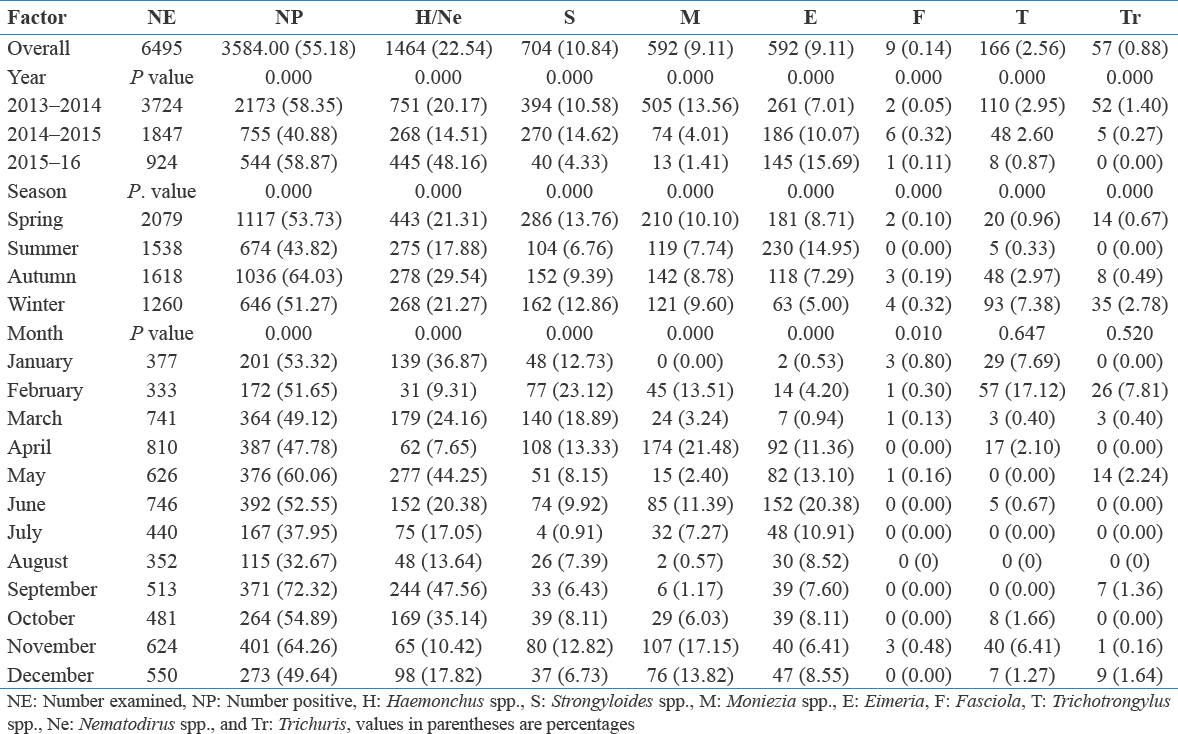INTRODUCTION
It is well known that the sheep rearing provides nutritional security and insurance to the farmer at the time of crisis due to crop failure. Therefore, sheep is a finance elevator for landless laborers, small and marginal farmers. Two major sources of income, meat and wool, make sheep industry a very profitable enterprise. In addition, the droppings of sheep are rich source of nitrogen, phosphorus, etc., which are used to improve soil fertility. However, a major and important limiting factor of sheep productivity is Gastrointestinal Tract (GIT) parasitic infection has a highly detrimental effect on the sheep industry. The infection caused by GIT nematodes in sheep has a worldwide distribution, with higher prevalence in temperate areas where climatic conditions favor the development of free-living stages of parasites (Martinez et al., 2013). The GIT infestations are neglected in spite of cosmopolitan distribution and huge economic losses caused by them. To adopt suitable control measures for parasitic infestation and to enhance sheep production, the epidemiological pattern of parasitic fauna needs to be understood. Therefore, a study was designed to find out the prevalence of GI parasites in sheep in Kashmir Valley to develop efficient control measures.
MATERIALS AND METHODS
The study was conducted from the month of March 2013 in Kashmir Valley. The latitude and longitude of Kashmir Valley are 33.778°N and 76.576°E, respectively. The valley is bounded on all sides by mountains and average elevation of the valley is 5,300 feet ASL. The climate of the valley is temperate with four seasons. A total number of 6495 samples were randomly collected directly from the rectum and brought to the Disease Investigation Laboratory, Nowshera, Srinagar, in mini-polythene bags for qualitative examination. The samples were subjected to standard floatation technique as described by Soulsby (1982) to work out the prevalence of different genera of gastrointestinal parasites. The data were classified based on months (1–12 months), seasons (1–4 seasons), and years (2013–2014, 2014–2015, 2015-2016, i.e., 1–3 years). The data obtained were analyzed on % age basis in SPSS and statistical significance of different effect was obtained by non-parametric Chi-square test.
RESULTS AND DISCUSSION
The present study revealed an overall prevalence of cestodes, nematodes, and coccidian (GI parasites) of 55.18% [Table 1]. The study is in accordance with several other investigators who have reported similar findings from various parts of India with (69.70%) overall prevalence from Ladakh (Kuchai et al., 2011), 78.44% from Udaipur district of Rajasthan by Neelam et al., 2017, and Shah et al., 2018, also reported 46.70% prevalence from Kashmir Valley. The prevalence of Haemonchus (H)/Nematodirus (Ne), Strongyloides (S), Moniezia (M), Eimeria (E), Fasciola (F), Trichotrongylus (T), and Trichuris (Tr) was 22.54%, 10.84%, 9.11%, 9.11%, 0.14%, 2.56%, and 0.88%, respectively.
Table 1: Prevalence of gastrointestinal parasitic infection in sheep in Kashmir Valley
Yearly prevalence was Observed highest in 2015–2016 (58.87%) followed by 2013–2014 (58.35%) and 2014–2015 (40.88%). Seasonal variation revealed highest prevalence of GI parasites in autumn (64.03%), followed by spring (53.73%), winter (51.27%), and summer (43.82%), month-wise prevalence of GIT parasite over the years reported highest in September (72.32%), November (64.26%), May (60.06%), and least in July (37.95%) and August (32.67%). The year, season, and month wise difference were highly significant (P < 0.01).
The present study revealed that the infection status by the various GIT parasites was very high. The high prevalence of GIT parasites observed in the present study may be attributed to favorable climatic conditions of Kashmir Valley for parasitic survival and lower immunity of recently developed Kashmir Merino sheep. The sheep found in Kashmir are Kashmir Merino cross bred developed around 1960 for good quality fine wool, have lower adoptability (Rather et al., 2019) to region hence higher prevalence of GIT parasites was observed. Other factors such as close ground grazing habit of sheep and relatively less cleanliness may also contribute. The highest prevalence in Autumn may be attributed to the lack of adequate forage (or pasture) coupled with intensive management programs resulting in increased heard density, leading to increased flock or herd parasitism. Under unfavorable environmental conditions (extremely cold winter and hot summer) that are harmful to survival and development of the free-living larval stages outside the host, the fourth-stage larvae will go into a state of arrested development (or hypobiosis) in the GIT mucosa and remain in that state for 3–4 months. Changes in the weather (Autumn and Spring) lead to favorable environment which initiates the end of hypobiosis and thus increases the prevalence of parasitism (Pugh and Baird, 2012).
Pasture management is also one of the important factors to determine the GIT parasitic load. Overcrowding of pasture causes high stocking rate leading to overgrazing, which increases both the contamination of the pasture and the rates of exposure to infective larvae. Concurrent malnutrition or lower protein intake also predisposes to greater GIT parasitism (Pugh and Baird, 2012).
CONCLUSION
The present study revealed that the infection status by the various GIT parasites was very high with high significant (P < 0.01) difference between year, season, and months. Therefore, it is concluded that geographical and climatic conditions of this region favor GIT parasitic infestation. The animal husbandry practices, housing, and pasture management also contribute to variation of parasitic infestations. Further studied to estimate the economic impact of GIT parasitic should be undertaken. Farmers rearing Kashmir Merino should follow sheep calendar devised by the Department of Sheep Husbandry (Kashmir) and antihelmenitics drenching should be done after fecal examination.
